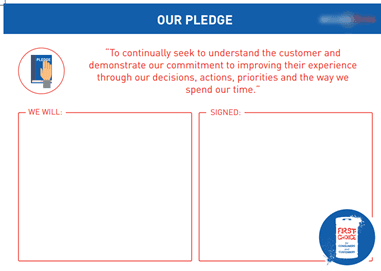I was on a call with a client the other day and they posed a question that I have heard frequently whilst working at B2B International…
“We have gathered lots of data and insights from the research but how do I go about driving action to improve the customer experience?”
It is a question I am always pleased to hear; far better to learn that there is some positive action being taken because of the research insights, beyond just a box-ticking exercise! Our clients have various roles in their businesses and have different amounts of time to work on improving the customer experience. Whilst we can work with specialists whose role is entirely focused on improving the customer experience, this is not always the case and we have many clients who wear multiple hats and who are particularly keen to understand the answer to the important question above. Below I highlight three ways in which I have seen businesses effectively drive action.
-
A Thank You
We start with a very simple action and one which we would advocate as part of any piece of customer research. We have asked for people’s time and feedback and as such, we should formally thank them for their participation in the research. I have seen clients provide a thank you in various different forms; through an email, via a telephone call and through a visit from an account manager. The way in which you typically deal with your customers and resources generally dictate the approach used but each has its own merit.
I have seen great ‘thank you’ approaches across all these avenues but the most effective ones are the ones that go further than a thank you. We have a great opportunity to let customers know that we are going to do something off the back of the research and covering off the topics “What you told us” and “What we intend to do” is crucial during these communications. We obviously need to be careful in what we tell customers so we do not set ourselves up for a fall but we need to be seen to be making changes for the future good.
-
Internal Action Workshops
I have always been a great believer in the attitude that customer experience is everyone’s role and not just a department. We therefore need to be making an effort to make cultural changes as a business, as opposed to putting the burden on one department, as this is the only way you are truly going to improve the experience for customers. Internal action workshops are a great way of doing this and can be highly effective in driving action.

One of the key elements that determine the success of these internal action workshops is making sure we have the right people attend. It is critical that we get members of the senior leadership team to attend to make sure we have buy in from the top. Second to that is making sure we have a subset of employees who cover all the different business functions. Remember this is a cultural change we are trying to make so it is important that all parts of the business are involved.
So we have the right people at the workshop, the next step is to get them to see and believe in the data and the insights from the research. An obvious way of doing this is to debrief the research through the form of a presentation. We should also aim to bring the research to life in as many ways as we can. It is important to include customer case studies as what better way to believe in the data than letting the internal teams hear the feedback directly from customers themselves through audio and video clips. We should also be making the most of the room that we are in by putting up key quotes and themes on the wall to help the findings sink in.
Top Tip – Another way to get customers engaged in the findings from the research is to give them some exercises to do during the workshop. Two potential exercises are as follows:
-
Be The Customer – get those at the workshop to fill in a short questionnaire either during or before the session. We should be asking the attendees a subset of the questions that we asked customers but making sure we get the answers in the eyes of the customers.
-
Be The Researcher – choose some of the research questions and let those at the workshop do some analysis themselves picking out the key delight factors and pain points that customers are currently noticing. This is particularly powerful before a presentation of the findings and is an excellent way to build trust and understanding of the research outputs.
Everybody at the workshop should now have a good understanding of the data and the insights from the research. Now that everybody is engaged and on-board we can now start to think about the actions that we would like to put in place to make the experience better for customers in the future. It is important to choose the right exercises in order to get the desired action.
We suggest running several different exercises in the workshops to determine the current customer experience, think about ways in which we can do things differently and to ultimately come up with some actions plans that can be put in place going forward. We would suggest choosing a small number of actions to implement as we know that resource is often limited in terms of both time and budgets. The actions put in place should be ones that will have a high impact on the customer experience.
To ensure we get action we suggest creating commitment sheets outlining the change that will be implemented, the next steps and the barriers. The final thing to determine is which department will own the commitment and which member of the senior leadership team will sponsor it whilst also giving a timeframe for the implementation of the improvement.
The number of commitments will depend on the amount of resource available but experience tells us that businesses that come up with more than three or four commitments at any given time are significantly less likely to actually go through and implement the changes.
Top Tip –Make the workshop memorable by getting all attendees to outline the changes that they are going to make to improve the customer experience and get them to sign a pledge as well.

-
-
Internal Dissemination Of Findings
The final suggested action would be to communicate and disseminate the findings of the research back internally to the wider employees. We have already talked about this being a cultural shift and it is important that the message gets across the whole of the business.
As employees we are frequently receiving different forms of communications from the business so it is important that the things we share stand out. We should therefore be imaginative in what we share and it should be more than just a standard email so think about creating videos, webinars and infographics to get the message across. If you have more time and budget you could consider developing customer persons, quizzes or even customer months to build customer experience traction.
So next time you conduct a piece of customer research, always go beyond just using it as a box ticking exercise and drive some action in your business for the future good of your customers.



